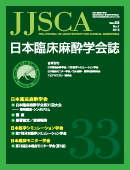Volume 33, Issue 1
Displaying 1-29 of 29 articles from this issue
- |<
- <
- 1
- >
- >|
Invited Lecture
-
2013Volume 33Issue 1 Pages 001-009
Published: 2013
Released on J-STAGE: March 12, 2013
Download PDF (494K)
Symposium (1)
-
2013Volume 33Issue 1 Pages 010
Published: 2013
Released on J-STAGE: March 12, 2013
Download PDF (135K) -
2013Volume 33Issue 1 Pages 011-016
Published: 2013
Released on J-STAGE: March 12, 2013
Download PDF (359K) -
2013Volume 33Issue 1 Pages 017-024
Published: 2013
Released on J-STAGE: March 12, 2013
Download PDF (508K) -
2013Volume 33Issue 1 Pages 025-031
Published: 2013
Released on J-STAGE: March 12, 2013
Download PDF (994K)
Symposium (2)
-
2013Volume 33Issue 1 Pages 032
Published: 2013
Released on J-STAGE: March 12, 2013
Download PDF (116K) -
2013Volume 33Issue 1 Pages 033-040
Published: 2013
Released on J-STAGE: March 12, 2013
Download PDF (699K) -
2013Volume 33Issue 1 Pages 041-050
Published: 2013
Released on J-STAGE: March 12, 2013
Download PDF (961K) -
2013Volume 33Issue 1 Pages 051-055
Published: 2013
Released on J-STAGE: March 12, 2013
Download PDF (375K) -
2013Volume 33Issue 1 Pages 056-063
Published: 2013
Released on J-STAGE: March 12, 2013
Download PDF (831K)
Lectures
-
2013Volume 33Issue 1 Pages 064-069
Published: 2013
Released on J-STAGE: March 12, 2013
Download PDF (417K)
Original Articles
-
2013Volume 33Issue 1 Pages 070-074
Published: 2013
Released on J-STAGE: March 12, 2013
Download PDF (387K) -
2013Volume 33Issue 1 Pages 075-083
Published: 2013
Released on J-STAGE: March 12, 2013
Download PDF (836K)
Case Reports
-
2013Volume 33Issue 1 Pages 084-087
Published: 2013
Released on J-STAGE: March 12, 2013
Download PDF (1518K) -
2013Volume 33Issue 1 Pages 088-091
Published: 2013
Released on J-STAGE: March 12, 2013
Download PDF (422K) -
2013Volume 33Issue 1 Pages 092-095
Published: 2013
Released on J-STAGE: March 12, 2013
Download PDF (352K) -
2013Volume 33Issue 1 Pages 096-100
Published: 2013
Released on J-STAGE: March 12, 2013
Download PDF (525K) -
2013Volume 33Issue 1 Pages 101-105
Published: 2013
Released on J-STAGE: March 12, 2013
Download PDF (367K) -
2013Volume 33Issue 1 Pages 106-109
Published: 2013
Released on J-STAGE: March 12, 2013
Download PDF (461K)
[JAMS] Keynote Lecture
-
2013Volume 33Issue 1 Pages 112-116
Published: 2013
Released on J-STAGE: March 12, 2013
Download PDF (551K)
[JAMS] Educational Lecture
-
2013Volume 33Issue 1 Pages 117-123
Published: 2013
Released on J-STAGE: March 12, 2013
Download PDF (1025K)
[JAMS] Symposium
-
2013Volume 33Issue 1 Pages 124-125
Published: 2013
Released on J-STAGE: March 12, 2013
Download PDF (208K) -
2013Volume 33Issue 1 Pages 126-130
Published: 2013
Released on J-STAGE: March 12, 2013
Download PDF (433K) -
2013Volume 33Issue 1 Pages 131-136
Published: 2013
Released on J-STAGE: March 12, 2013
Download PDF (670K) -
2013Volume 33Issue 1 Pages 137-141
Published: 2013
Released on J-STAGE: March 12, 2013
Download PDF (1311K) -
2013Volume 33Issue 1 Pages 142-147
Published: 2013
Released on J-STAGE: March 12, 2013
Download PDF (453K)
[JACM] Symposium
-
2013Volume 33Issue 1 Pages 150-155
Published: 2013
Released on J-STAGE: March 12, 2013
Download PDF (937K) -
2013Volume 33Issue 1 Pages 156-160
Published: 2013
Released on J-STAGE: March 12, 2013
Download PDF (851K)
-
2013Volume 33Issue 1 Pages 162
Published: 2013
Released on J-STAGE: March 21, 2013
Download PDF (68K)
- |<
- <
- 1
- >
- >|
